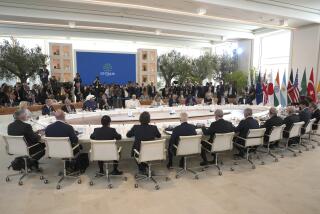G7 Officials Hint at Currency Intervention
WASHINGTON — Seven of the world’s richest countries signaled global currency traders Sunday they would support dumping billions of dollars on exchange markets if the soaring greenback doesn’t stabilize.
After meeting privately at the Treasury Building for about five hours, finance ministers and central bank heads of the United States, Japan, Germany, Britain, France, Canada and Italy issued a statement saying, “We agreed to monitor developments and to cooperate as appropriate in exchange markets.”
This was taken by analysts as a veiled threat in support of intervention in currency markets by Japan and the United States, if necessary, by purchasing massive amounts of yen and selling dollars.
“That’s a direct shot over the bow to foreign exchange traders,” said economist David Jones of Aubrey G. Lanston & Co. in New York. “They not only want the dollar to stabilize, but they’re willing to intervene in a cooperative way to achieve the goal.”
In advance of the meeting, Treasury Secretary Robert Rubin met one-on-one with Hiroshi Mitsuzuka, Japan’s finance minister. In a slightly stronger statement than the G-7 communique, the two “reaffirmed their commitment to cooperate closely in exchange markets as appropriate,” the Treasury said.
Two weeks ago, as the yen sank to a 4 1/2-year low against the dollar, Japanese officials hinted they were prepared to intervene to check their currency’s deterioration.
Rubin has said he shares Japanese officials’ concern, but until now he has refused to discuss publicly the possibility of the United States joining any intervention. Intervention by the G-7 countries’ central banks would pack more wallop in world markets than Japanese intervention alone.
Central banks don’t have enough reserves to control exchange rates outright but can make traders wary of pushing the dollar too high by intervening now and again to cause unexpected losses.
When the G-7 ministers last met, in Berlin in February, they signaled that the dollar’s nearly two-year recovery from a post-World War II low of 80 yen had gone far enough.
“Major misalignments in exchange markets . . . have been corrected,” they said.
At that time, the dollar had rebounded about 50% against the yen and 25% against the German mark. Since then, it’s pushed up 3% to 4% and traded at 126.25 yen late Friday in New York.
From Japan’s point of view, the sliding yen threatens to undermine global confidence in its shaky financial markets. From the U.S. perspective, a strengthening greenback hurts the trade deficit by making American goods more expensive on overseas markets.
More to Read
Sign up for Essential California
The most important California stories and recommendations in your inbox every morning.
You may occasionally receive promotional content from the Los Angeles Times.










